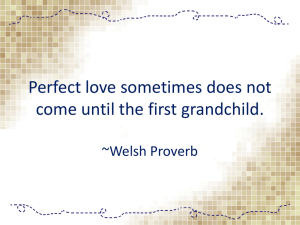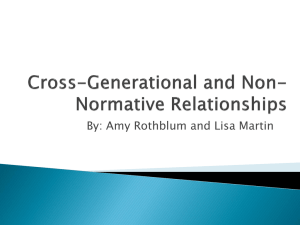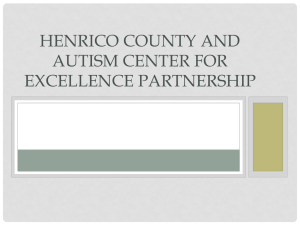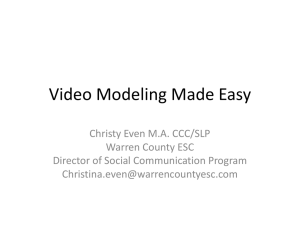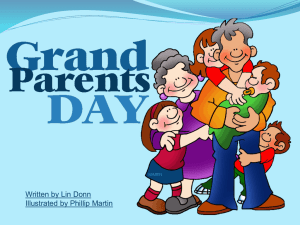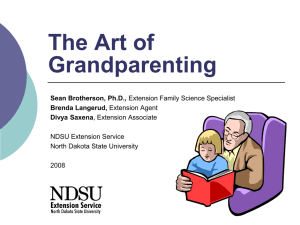s - iStar
advertisement
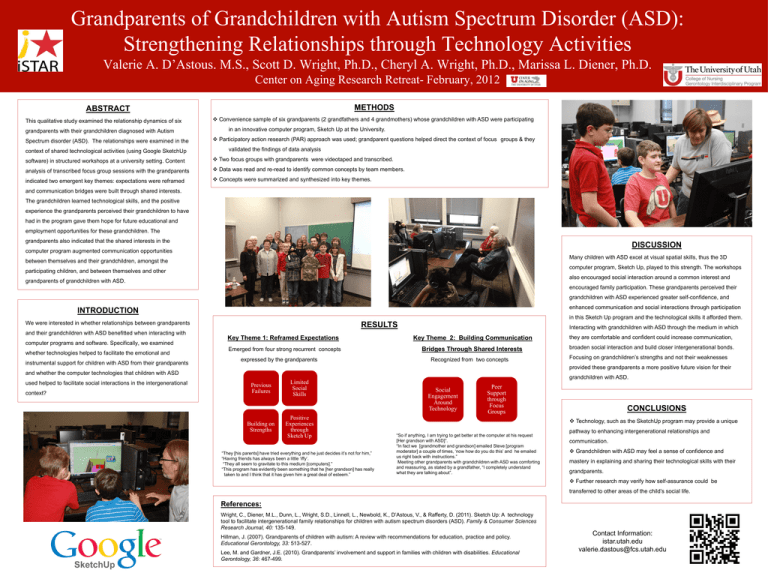
Grandparents of Grandchildren with Autism Spectrum Disorder (ASD): Strengthening Relationships through Technology Activities Valerie A. D’Astous. M.S., Scott D. Wright, Ph.D., Cheryl A. Wright, Ph.D., Marissa L. Diener, Ph.D. Center on Aging Research Retreat- February, 2012 METHODS ABSTRACT This qualitative study examined the relationship dynamics of six grandparents with their grandchildren diagnosed with Autism Spectrum disorder (ASD). The relationships were examined in the context of shared technological activities (using Google SketchUp Convenience sample of six grandparents (2 grandfathers and 4 grandmothers) whose grandchildren with ASD were participating in an innovative computer program, Sketch Up at the University. Participatory action research (PAR) approach was used; grandparent questions helped direct the context of focus groups & they validated the findings of data analysis software) in structured workshops at a university setting. Content Two focus groups with grandparents were videotaped and transcribed. analysis of transcribed focus group sessions with the grandparents Data was read and re-read to identify common concepts by team members. indicated two emergent key themes: expectations were reframed Concepts were summarized and synthesized into key themes. and communication bridges were built through shared interests. The grandchildren learned technological skills, and the positive experience the grandparents perceived their grandchildren to have had in the program gave them hope for future educational and employment opportunities for these grandchildren. The grandparents also indicated that the shared interests in the DISCUSSION computer program augmented communication opportunities Many children with ASD excel at visual spatial skills, thus the 3D between themselves and their grandchildren, amongst the computer program, Sketch Up, played to this strength. The workshops participating children, and between themselves and other also encouraged social interaction around a common interest and grandparents of grandchildren with ASD. encouraged family participation. These grandparents perceived their grandchildren with ASD experienced greater self-confidence, and enhanced communication and social interactions through participation INTRODUCTION in this Sketch Up program and the technological skills it afforded them. We were interested in whether relationships between grandparents and their grandchildren with ASD benefitted when interacting with computer programs and software. Specifically, we examined whether technologies helped to facilitate the emotional and instrumental support for children with ASD from their grandparents RESULTS Interacting with grandchildren with ASD through the medium in which Key Theme 1: Reframed Expectations Key Theme 2: Building Communication they are comfortable and confident could increase communication, Emerged from four strong recurrent concepts Bridges Through Shared Interests broaden social interaction and build closer intergenerational bonds. expressed by the grandparents Recognized from two concepts provided these grandparents a more positive future vision for their and whether the computer technologies that children with ASD used helped to facilitate social interactions in the intergenerational context? Focusing on grandchildren’s strengths and not their weaknesses Previous Failures Building on Strengths Limited Social Skills Positive Experiences through Sketch Up “They [his parents] have tried everything and he just decides it’s not for him,” “Having friends has always been a little ‘iffy’. “They all seem to gravitate to this medium [computers].” “This program has evidently been something that he [her grandson] has really taken to and I think that it has given him a great deal of esteem.” grandchildren with ASD. Social Engagement Around Technology Peer Support through Focus Groups CONCLUSIONS Technology, such as the SketchUp program may provide a unique “So if anything, I am trying to get better at the computer at his request [Her grandson with ASD]”. “In fact we [grandmother and grandson] emailed Steve [program moderator] a couple of times, ‘now how do you do this’ and he emailed us right back with instructions.” Meeting other grandparents with grandchildren with ASD was comforting and reassuring, as stated by a grandfather, “I completely understand what they are talking about”. pathway to enhancing intergenerational relationships and communication. Grandchildren with ASD may feel a sense of confidence and mastery in explaining and sharing their technological skills with their grandparents. Further research may verify how self-assurance could be transferred to other areas of the child’s social life. References: Wright, C., Diener, M.L., Dunn, L., Wright, S.D., Linnell, L., Newbold, K., D’Astous, V., & Rafferty, D. (2011). Sketch Up: A technology tool to facilitate intergenerational family relationships for children with autism spectrum disorders (ASD). Family & Consumer Sciences Research Journal, 40: 135-149. Hillman, J. (2007). Grandparents of children with autism: A review with recommendations for education, practice and policy. Educational Gerontology, 33: 513-527. Lee, M. and Gardner, J.E. (2010). Grandparents’ involvement and support in families with children with disabilities. Educational Gerontology, 36: 467-499. Contact Information: istar.utah.edu valerie.dastous@fcs.utah.edu

